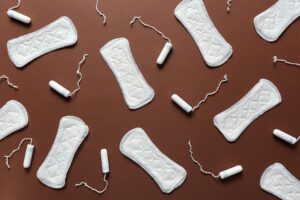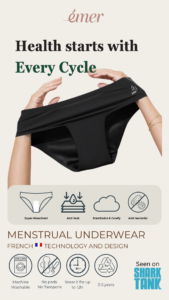By Celine Ventalon, CEO & Founder, Emer –
The topic of sustainable menstrual health is both personal and pivotal to our collective future. In a world increasingly focused on health, sustainability, and equity, the conversation around menstrual health has never been more vital. Traditional menstrual products come with significant health and environmental drawbacks, underscoring the need for innovative, sustainable solutions.
Let’s delve into the challenges of menstrual health and the transformative power of sustainable alternatives.
The Challenges of Menstrual Health
Period Poverty
Period poverty is a pervasive issue affecting millions of women globally. Limited access to safe and hygienic menstrual products poses severe health risks and creates barriers to education and economic opportunities. I vividly remember my first visit to a community center in Vietnam, where I met young girls who missed school every month because they couldn’t afford proper menstrual products.
Studies show that 63% of women and girls have regularly missed school or work due to their periods. Additionally, two-thirds of low-income women cannot afford menstrual hygiene products, often resorting to improvised solutions that can lead to infections and other health problems. Addressing period poverty is crucial to ensuring that all women have access to the products they need for safe and dignified menstrual health.
Health Risks of Traditional Products
 Traditional menstrual products, like pads and tampons, often contain small quantities of chemicals that can accumulate in the body over time, potentially causing fertility issues and, in severe cases, cancer. I’ve spoken with numerous women who shared their struggles with discomfort and irritation from these products, echoing the statistic that about 75% of women report dissatisfaction with them. These health risks highlight the urgent need for safer, non-toxic alternatives.
Traditional menstrual products, like pads and tampons, often contain small quantities of chemicals that can accumulate in the body over time, potentially causing fertility issues and, in severe cases, cancer. I’ve spoken with numerous women who shared their struggles with discomfort and irritation from these products, echoing the statistic that about 75% of women report dissatisfaction with them. These health risks highlight the urgent need for safer, non-toxic alternatives.
Promoting Sustainability
Environmental Impact of Disposable Products
Disposable menstrual products are major contributors to plastic pollution, ranking among the top ten sources of plastic waste. The environmental impact is staggering, with each woman discarding approximately 17,000 pads and tampons over her lifetime.
I still remember the moment I learned about the enormous pile of waste a single person can generate—it’s a wake-up call. These products not only add to landfills but also contribute to ocean pollution. In Vietnam, where waste management infrastructure is still developing, the issue is exacerbated, contributing significantly to pollution problems. The United Nations’ Sustainable Development Goals plan to ban disposable plastics by 2030, emphasizing the urgent need for sustainable alternatives.
Eco-Friendly Alternatives
Eco-friendly menstrual products, such as period panties and menstrual cups, offer sustainable solutions. These products are reusable for multiple years and are crafted using certified materials free from harmful substances, resulting in minimal environmental impact.
When I first switched to reusable products, I was amazed at how much waste I reduced and how much more comfortable I felt. By choosing reusable products, women can significantly reduce their ecological footprint, aligning with broader environmental goals.
Promoting Awareness and Breaking the Stigma
Menstruation remains a taboo subject in many parts of the world, including Vietnam. Education is a powerful tool in promoting menstrual health and sustainability. Workshops and educational initiatives in schools and workplaces help dismantle stigmas and foster openness about menstrual health.
I’ve had the privilege of leading workshops where I saw first-hand the power of education in transforming attitudes and empowering young women. These initiatives provide valuable information and empower individuals to make informed choices about their menstrual health and product use.
Innovative Solutions
Menstrual Cups
Made from medical-grade silicone, menstrual cups are reusable and can last for several years. They offer a cost-effective and eco-friendly alternative to disposable products, significantly reducing waste.
I recall my initial skepticism about menstrual cups, but with practice, they became a reliable and liberating option. However, menstrual cups can be challenging to use for some, requiring practice for insertion and removal, which can be uncomfortable, particularly for younger girls and those not accustomed to internal menstrual products.
 Menstrual Panties and Swimsuits
Menstrual Panties and Swimsuits
Period panties and menstrual swimwear represent a revolutionary shift in menstrual products. Designed with advanced absorbent technology, these garments offer leak-proof protection and comfort throughout the day.
I remember trying period panties for the first time and being amazed by their comfort and effectiveness. Available in various styles and absorbency levels, menstrual lingerie can be worn and reused like regular underwear. Menstrual swimwear allows women to swim comfortably and confidently during their period.
Empowerment of Women and Sustainability
Promoting sustainable menstrual health is a clear mission: empowering women and supporting environmental sustainability through innovative solutions. I am glad that I can do it in my role as CEO and founder of Emer.
By addressing period poverty, providing educational resources, and championing eco-friendly practices, the shift towards healthier, more sustainable menstrual products is well underway.
Personally, seeing the positive impact on women’s lives and the environment has been incredibly rewarding, reinforcing my belief in the importance of this mission.
For more information on sustainable menstrual solutions, visit Emer.
All views and opinions expressed on this site are those of the individual authors and comments on this site are the sole responsibility of the individual contributor.

